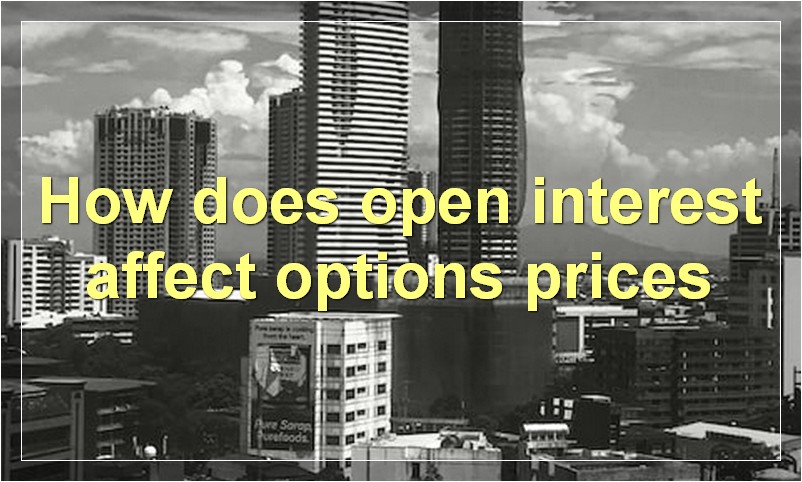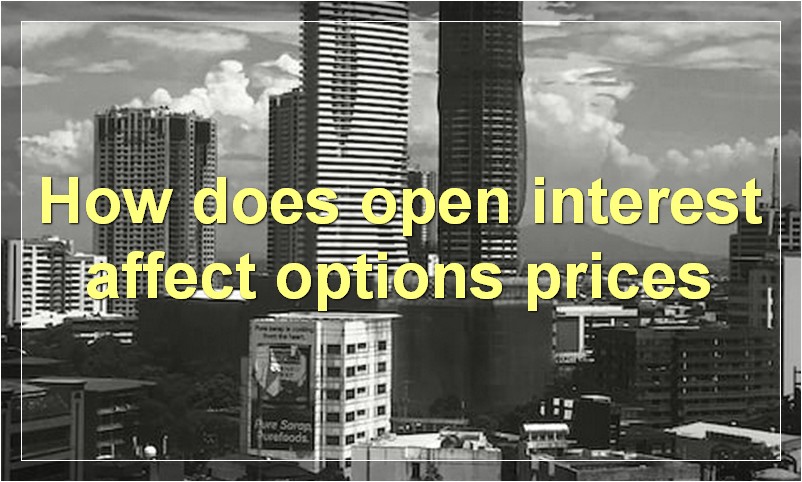A recent study showed that options trading is becoming more popular among investors. This is likely due to the fact that options offer a high degree of flexibility, allowing investors to tailor their positions to their specific goals.
What is open interest and how is it used in options trading
When it comes to options trading, open interest is an important concept to understand. Open interest represents the total number of open contracts for a particular security. For example, if there are 100 call option contracts and 100 put option contracts outstanding for a particular stock, the open interest would be 200.
Open interest can be used to gauge market sentiment in options trading. If the open interest is increasing for a particular security, it means that more traders are taking positions in that security. This can be used as a leading indicator of future price movement.
Open interest can also be used to determine the level of liquidity in the options market. If there is high open interest, it means there are more traders participating and there is more liquidity. This can make it easier to trade options and get in and out of positions.
If you’re trading options, it’s important to keep an eye on open interest levels. By understanding how open interest works, you can get a better sense of market sentiment and gauge the liquidity of the options market.
How does open interest affect options prices

Open interest is the number of outstanding contracts that exist for a particular security. It is important to options traders because it provides information about the liquidity of the options market for a particular security. The higher the open interest, the more liquid the market is and the easier it is to trade. The lower the open interest, the less liquid the market is and the harder it is to trade.
Open interest can also affect options prices. When there is high open interest, it means there are a lot of traders interested in that security and the price of the option will be higher. When there is low open interest, it means there are fewer traders interested in that security and the price of the option will be lower.
What is the difference between open interest and volume when trading options
Open interest is the number of outstanding contracts that exist for a particular security. Volume, on the other hand, is the number of contracts that are traded during a given period of time.
One way to think of the difference between open interest and volume is that open interest represents the number of “buyers” and “sellers” in the market, while volume represents the number of actual transactions that take place.
For example, let’s say there are 100 contracts for a particular stock option with an open interest of 50. This means that there are 50 “buyers” and 50 “sellers” in the market. If the volume for this stock option is 25 for a given day, this means that 25 contracts were traded between buyers and sellers during that day.
How can you use open interest to gauge market sentiment in options trading
When trading options, open interest is the number of outstanding contracts that have not yet been exercised or expired. This number can be used to gauge market sentiment because it shows how many traders are currently holding positions in the market. If open interest is increasing, it means that more traders are entering the market and buying options contracts. This is generally seen as a bullish sign, as it indicates that there is strong demand for the options. Conversely, if open interest is decreasing, it means that fewer traders are holding positions in the market. This can be seen as a bearish sign, as it indicates that there is weak demand for the options.
What are some strategies for trading options with high open interest
Some strategies for trading options with high open interest are to buy calls when the market is going up, and to buy puts when the market is going down. Another strategy is to buy calls or puts when there is high open interest in the option. This usually happens when there is a lot of news about the underlying stock.
What are some risks associated with trading options with high open interest

When it comes to trading options with high open interest, there are a few risks that you need to be aware of. First and foremost, because there is more money involved in these trades, the potential for loss is greater. Additionally, you may find yourself getting caught up in the excitement of the trade and making impulsive decisions that you later regret. Finally, you need to be extra careful when monitoring your positions, as even small changes in the market can have a big impact on your profitability.
What is the relationship between open interest and liquidity in options trading
The relationship between open interest and liquidity in options trading is an important one. Liquidity refers to the ability of a market to handle large trades without having a significant impact on the price of the underlying asset. Open interest, on the other hand, is the number of outstanding contracts for a particular option. This number can give traders an idea of the level of activity in the market for that particular option.
Generally speaking, high levels of open interest will lead to high levels of liquidity. This is because more contracts means more potential buyers and sellers, which makes it easier to trade without moving the price too much. However, there are some cases where high levels of open interest can actually lead to low liquidity. This is often seen when there is a lot of speculation going on around a particular event, such as an earnings release. In these cases, the market can become very volatile and it can be hard to find someone willing to take the other side of your trade.
Overall, the relationship between open interest and liquidity is a complex one. It is important to keep an eye on both factors when trading options so that you can make the best decisions possible.
How can open interest be used to measure market activity in options trading
Open interest is the number of outstanding contracts on a particular security. It is used to measure market activity in options trading because it represents the number of open positions that have not been closed. The higher the open interest, the more active the market is.
What are some benefits of trading options with high open interest
Open interest is the number of open contracts for a particular security. It is a measure of market activity and liquidity, as well as the number of traders involved in a particular market.
High open interest means that there are a lot of traders interested in the market, which makes it more liquid and easier to trade. It also means that there is a greater chance of price movement, making it more profitable to trade options.
Are there any drawbacks to trading options with high open interest
Yes, there are some drawbacks to trading options with high open interest. The main one is that the options may be more expensive than those with lower open interest. This is because there is more demand for the options, so the prices are driven up. Another potential drawback is that there may be more liquidity in the options with lower open interest, so it may be harder to find a buyer or seller when you want to trade.

